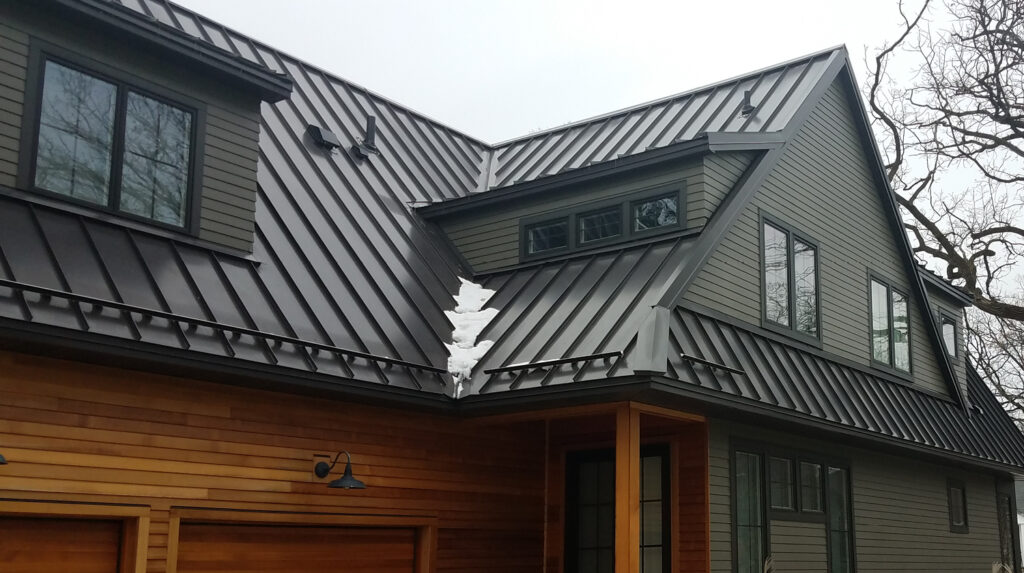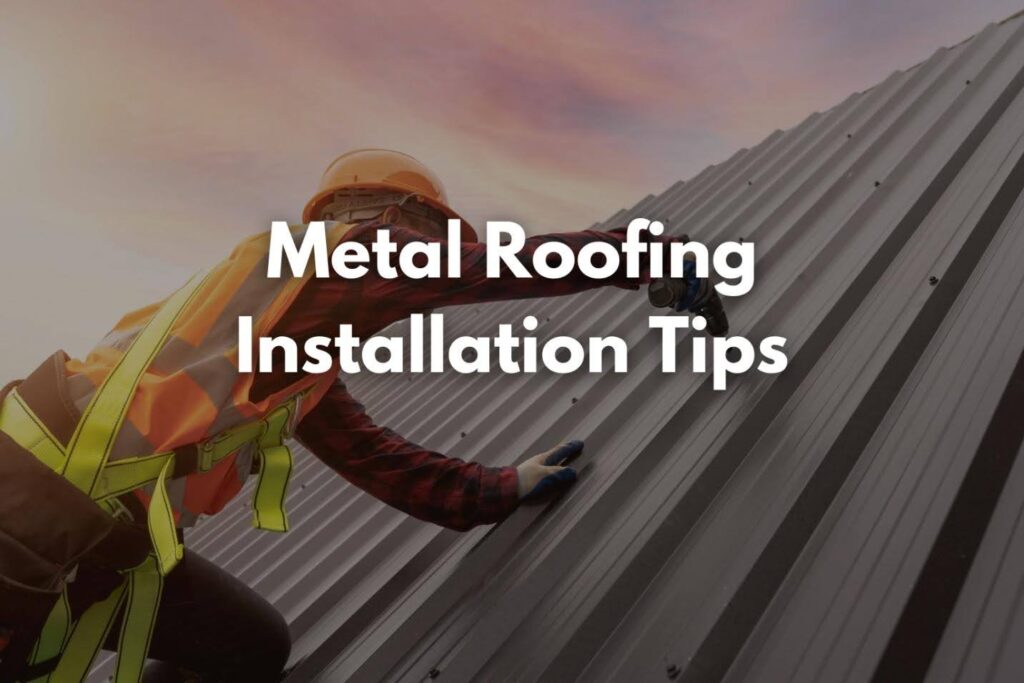Metal roofs are known for their strength and long life, making them a popular choice in today’s building world. They are great at handling tough weather, last a long time, and are good for the environment. This article is designed to be a detailed guide, perfect for anyone looking to understand how to install a metal roof.
I’ll cover everything from picking the best materials to mastering the installation process. The tips provided here are simple to follow and aimed at helping you achieve a durable and effective metal roof installation.

Choosing the Right Type of Metal, Panels, and Fastening Method
Selecting the right materials is a crucial first step in metal roofing. Different metals have their advantages. For instance, aluminium is great for resisting rust, steel is admired for its strength, and copper is known for lasting a long time. Equally important is the choice of panels.
For a modern look, standing seam panels are ideal as they hide fasteners, creating a sleek finish. On the other hand, corrugated panels are more traditional in appearance and are less expensive, making them a budget-friendly option.
The way you attach these panels to your roof, known as the fastening method, also varies. It can be done using screws, nails, or clips. This choice largely depends on what kind of panel you’re using and the specific needs of your roof.
By carefully choosing the right metal, panel type, and fastening method, you can ensure your roof not only looks good but also performs well over time.
Using a Good Quality Metal Roof Underlayment
Selecting the right underlayment is a key step in metal roof installation. Think of underlayment as a protective layer that sits beneath your metal roof, guarding against water. It’s especially important because it acts as a backup barrier if water somehow gets past the metal.
Nowadays, many people prefer synthetic underlayments over traditional felt options. Why? Because synthetics tend to last longer and are better at keeping water out. Plus, they’re stronger, which means they can handle tough weather conditions better.
When you’re installing this underlayment, it’s crucial to lay it down smoothly and secure it well. If it’s bumpy or wrinkled, not only will it look bad, but it might also not work as effectively. A well-installed underlayment will keep your roof looking good and functioning properly for a longer time, protecting your home from rain, snow, and other elements.
Proper Screw Fastening Techniques
A metal roof’s durability greatly depends on how well the screws are fastened. It’s essential to pick screws that are compatible with your roof’s metal. This helps prevent rust and ensures a strong hold. The size of the screws is also important – they need to be just right to attach securely.
When it comes to placing the screws, accuracy is crucial. They should go straight down to the roof. This way, they grip better and spread the weight evenly across the roof. It’s also important to space them out just right. If they’re too close or too far apart, it can weaken the roof’s hold.
Be careful not to tighten the screws too much. If they’re screwed in too hard, they can get stripped. This means they won’t hold as well and could even cause leaks. The right screw fastening technique is key to keeping your roof watertight and strong for a long time.

Considerations for Installing Metal Roofing Directly on Plywood
When you’re installing metal roofing on plywood, it’s really important to get everything set up right from the start. Make sure the plywood is in good shape – it should be clean, dry, and smooth. This helps the metal roof lay flat and stay secure.
One great thing about using plywood as a base is that it gives strong support to the metal roof. However, there’s a chance that moisture can build up underneath the metal. To stop this from happening, you should put a moisture barrier between the plywood and the metal sheets. This barrier keeps water out, protecting your roof and the inside of your house.
Now, when you’re putting the metal sheets onto the plywood, take your time and do it step by step. Line up each sheet of metal carefully and make sure it’s fixed on tightly. If you line everything up right and secure it well, your metal roof will be set up for success.
Pay Attention to Ventilation
Good ventilation is key for a metal roof. It helps control how warm or cool your roof gets and deals with moisture. In simple terms, when you have the right ventilation, your roof doesn’t get too hot in the summer or too damp in the winter.
To do this, put vents along the top ridge of your roof and near the lower edges (these are called soffit areas). These vents let air flow in and out, keeping your roof in good shape and working well. Think of it like breathing: your roof needs to ‘inhale’ fresh air and ‘exhale’ stale air to stay healthy.
Invest in Proper Roof Insulation
Insulating your metal roof is crucial for its overall performance. Essentially, insulation helps control the temperature inside your building and reduces outside noise. For metal roofs, the best insulation materials are usually foam batting or rigid foam panels.
These materials work well because they fit snugly against the metal, reducing heat loss in winter and keeping your space cooler in summer.
When installing insulation, it’s important to do it correctly. Make sure to cover the entire area under your metal roof without leaving any spaces. If there are gaps, you might experience what’s called ‘thermal bridging.’
This is when heat passes through the uninsulated parts of the roof, making your insulation less effective. So, to keep your building energy-efficient and comfortable spread the insulation evenly across the entire roof.
Avoiding Common Installation Mistakes
When installing a metal roof, a few frequent mistakes can cause significant problems down the line. These include not fastening the panels correctly, placing the panels unevenly, and not sealing the edges adequately. Such errors can cause water leaks, decrease the lifespan of your roof, and affect its overall look. To prevent these issues, it’s essential to follow these straightforward steps:
- Double-Check Measurements: Before you start, make sure all your measurements are accurate. This step is crucial to ensure that everything fits perfectly and reduces the need for adjustments later.
- Align Panels Properly: Take extra care to line up the panels neatly. Misaligned panels not only look bad but can also lead to gaps where water can seep through.
- Use Quality Sealants: A good sealant is key to preventing leaks. Choose a high-quality product and apply it carefully, especially around the edges and joints.
By paying attention to these details, you can avoid common mistakes that could otherwise lead to more work and expenses in the future. Simple measures like these can make a big difference in the success of your metal roofing project.
Hire Skilled Metal Roofing Professionals
For a successful metal roof job, it’s important to choose the right team. This kind of work needs special skills and knowledge. When you’re looking for a roofing contractor, pick one that is expert in metal roofs and offers quality roof installation services. Their special skills are really important for this kind of work.
To decide well, check out their past work and what qualifications they have. Good signs of their work quality are things like customer reviews or photos of their past projects. Choosing a team with lots of experience can make the whole roofing process go smoother and more reliably.
Common Pitfalls to Avoid During Metal Roof Installation
Installing a metal roof requires precision, and overlooking small details can lead to significant problems. Two major issues often encountered are inadequate sealing and disregarding local building regulations.
Firstly, proper sealing is crucial. If not done correctly, gaps can form, leading to water leaks. These leaks might seem minor at first but can cause extensive damage over time. Ensure every joint, edge, and fastening point is sealed properly to prevent water intrusion.
Secondly, it’s essential to adhere to local building codes. These codes are in place to ensure safety and quality. Ignoring them can not only compromise the integrity of your roof but also lead to legal complications. Always check with local authorities about the specific requirements for metal roofing in your area.
Regular roof check-ups play a vital role in maintaining its condition. Periodic inspections can spot potential issues like loose panels or sealant failures, allowing for timely repairs. This proactive approach helps in avoiding bigger problems down the line.
Conclusion
Metal roofing installation is a complex but rewarding process. Homeowners and builders can ensure a successful metal roof installation by understanding the importance of material selection, proper installation techniques, and the value of professional expertise.
The key lies in meticulous planning and execution, ensuring that the roof enhances the building’s aesthetic and provides long-term protection and efficiency.






